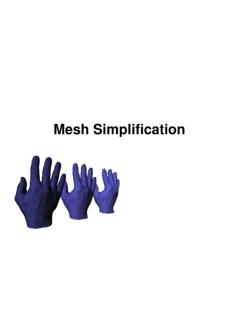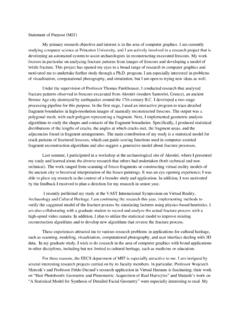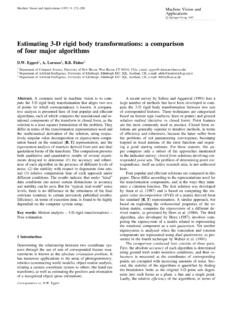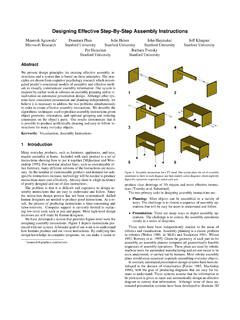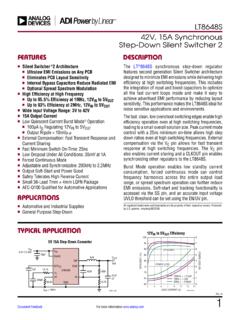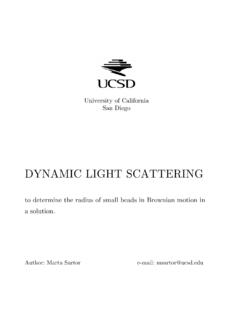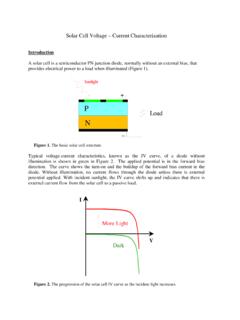Transcription of ABSTRACT AND INTRODUCTION - Stanford University
1 Copyright 2010 Douglas A. Kerr. May be reproduced and/or distributed but only intact, including this notice. Brief excerpts may be reproduced with credit. The CIE XYZ and xyY color Spaces Douglas A. Kerr Issue 1 March 21, 2010 ABSTRACT AND INTRODUCTION A color Space is a completely-specified scheme for describing the color of light, ordinarily using three numerical values (called coordinates). An important color space, defined by the International Commission on Illumination (CIE, the initials of its French name) is the CIE XYZ color space. It is widely used in scientific work, and color descriptions in other color spaces are often related to their representation in this space. A derivative of this color space, the CIE xyY color space, is often used as a way to graphically present the chromaticity of colors.
2 The XYZ color space itself has a fascinating genesis. Its nature, history, and role in both theoretical and practical color science are described in this article, along with that of its cousin, the CIE xyY color space. The article begins with a review of several important technical concepts that are involved in the story. BACKGROUND Our work on this topic requires an accurate grasp of a number of fundamental matters in the area of colorimetry. Here I will review some of those topics and other critical matters. color color is a property that distinguishes among different kinds of light. It is defined wholly in terms of human perception. If two instances of light appear to a viewer to be the same color1, they are the same color .
3 color , as we use the term in the technical sense, is usually recognized by the viewer as having two aspects: 1 I have to add, for rigor, if observed under the same conditions . The subtlety that this honors, the matter of chromatic adaptation, will not play a role in this article. The CIE XYZ and xyY color Spaces Page 2 Luminance, which we can think of for our purposes as an indication of the brightness of the Chromaticity, the property that distinguishes red from blue, and red from pink. (This is the property that lay people typically think is meant by color , but the technical concept of color embraces luminance as well.) What determines the color of light? color is not a primary physical property like the temperature or pressure of a gas.
4 We can, however, ascertain the color of an instance of light by physical measurements which will predict for us the eye s response to it. The physical property of the light that gives it its color is its spectrum ,3 the plot of distribution of the power in the light over the range of wavelengths that can affect the eye (the visible wavelengths ). The shape of the plot determines the chromaticity of the light; its overall vertical scale determines its luminance. That is, if we have two different instances of light, whose spectrums have the same shape, but for one instance is proportionately stretched vertically, the two instances have the same chromaticity, but the second one has a greater luminance.
5 In the other direction, things are not nearly so tidy. We can have several instances of light with different spectrums which nevertheless have the same color . In fact there are an infinity of spectrums that will have any given color . This situation is called metamerism, and different spectrums having the same color are called metamers of the color . color spaces It has been long recognized that, as perceived by most human observers, any color of light can be specified by stating three numerical values. That is, color is three-dimensional in the mathematical (not geometric) sense. 2 There is a subtle but important formal distinction between luminance and brightness, but for our purpose here we can ignore it.
6 3 The formal name of this is the power spectral distribution (PSD) of the light. The CIE XYZ and xyY color Spaces Page 3 There are, however, many different schemes of coordinates under which these three numerical values can be defined. These schemes, when fully specified as to their details, are called color spaces. There are several basic schemes, and for each, there are usually several different standard, fully-specified forms. One important scheme is the additive scheme. Additive color spaces work by stating the amounts of three kinds of light (called the primaries of the color space), having different, and precisely specified, chromaticities, which if actually added together would create light of the color being described. This can be thought of both as a recipe for actually creating light of that color (as in a display screen) and as an ABSTRACT way to describe that color .
7 The three amount values are said to be the three coordinates (under the specific color space) of the color of interest. Tristimulus color spaces Additive-scheme color spaces can be called tristimulus color spaces, since they work by defining the amounts of three stimuli provided to the eye (the three primaries). However, it is a widespread custom to reserve the name tristimulus color space for a particular color space of this class, the CIE XYZ color space, the overall subject of this article. How the eye determines color It has been determined that (for fairly substantial luminance) the eye observes each tiny element of the image on the retina with three kinds of cones , which are photodetectors 4. Each kind has a different spectral response, by which we mean a curve that tells how much output the cone delivers from light of a fixed potency at each wavelength over the visible range.
8 When an area on the retina is bathed in light with a certain spectrum , in effect, for each of the three kinds of cones: The spectrum of the light is multiplied by the spectral response of the cone, meaning that, for each wavelength, the potency of the light at that wavelength is multiplied by the value of the spectral response at that wavelength. 4 There are a few humans ( tetrachromats ), all women, who have four kinds of cones. Accordingly, their perception of color requires four values to describe. The CIE XYZ and xyY color Spaces Page 4 All these products are added together5, giving the output of the cone. The three types of cone are called L , M , and S , referring to the fact that the peaks of their spectral responses are at different wavelengths, which we arbitrarily consider to be long , medium and short.
9 The spectral response curves of the three types of cone are called l, m, and s 6 (the usual typography is an overbar, but that is a pain to produce in this word processor, so I will underline them instead). We cannot actually determine these curves (formally described as response functions, since they are functions of wavelength). We can derive related curves by tedious visual experimentation (a process that will be discussed at length shortly), and from these indirectly come to conclusions as to the curves themselves. But different researchers have come to different conclusions. Figure 1 shows a popular conclusion as to these three response curves (scaled so that their peaks are all at 100 units). They are labeled here with the cone type names, L, M, and S, not the function names.
10 Figure 1. Eye cone response curves THE color MATCHING EXPERIMENTS We cannot directly determine the three response functions, l, m, and s, of the human eye, mainly because we can t put a meter on the outputs of the cones. 5 Since both the spectrum of the light and the spectral response function of the cone are continuous, the process is actually integration, not summation, but the concept is identical. 6 The mathematician would write then as l( ), m( ), and s( ), reminding us that all of them are functions of wavelength, . The CIE XYZ and xyY color Spaces Page 5 But color scientists were able to precisely characterize the response of the human eye in a way that is almost as useful to us as knowledge of these curves. This was done by a tedious series of experiments with actual human observers, done in around 1931.



